Jesus and the Relationship Between the Gospels
Answers to common questions asked about introductory issues concerning Jesus and the relationship between the Gospels.

1. Name the work from which this quote is taken: "On the eve of Passover they hanged Jesus the Nazarene."
While neither the writings of Philo nor the Dead Sea Scrolls mention Jesus by name, the Jewish historian Josephus makes at least two references to Jesus of Nazareth in his works called Jewish Antiquities.
The Babylonian Talmud is a collection of rabbinic teachings that was finalized in the sixth century. The Talmud refers to Jesus several times including the aforementioned quotation. The Talmud also contains at least one clear reference to Jesus's resurrection.[1]
2. From where is this quote taken? "Therefore, to squelch the rumor, Nero created scapegoats and subjected to the most refined tortures those whom the common people called 'Christians.'"
The roman historian Tacitus (ca. AD 56–113) wrote his Annals, and this quote is found in Annals 15.44. His work covered the history of Rome (AD 14–68), but some of the books were lost including the section discussing the years AD 29–32. If Jesus had been crucified in AD 30, the section describing the crucifixion would have been lost.[2]
The early non-Christian references to Jesus (including those written by Roman writers) are a testimony about Jesus from hostile witnesses.
3. From where is this quote taken, and what is the special name assigned to it? "At this time there was a wise man who was called Jesus. And his conduct was good, and he was known to be virtuous."
The testinomy of Josephus constitutes the most important early testimony about Jesus of Nazareth known outside of the Bible.
Josephus references Jesus in a passage known as the Testimonium Flavianum (Ant. 18.3.3 §§ 63–64). The Greek manuscripts of Josephus' work were likely edited by Christians who gave their interpolations.
At this time there was a wise man who was called Jesus. And his conduct was good, and he was known to be virtuous. And many people from among the Jews and the other nations became his disciples. Pilate condemned him to be crucified and to die. And those who have become his disciples did not abandon his discipleship. They reported that he had appeared to them three days after his crucifixion and that he was alive; accordingly he was perhaps the Messiah concerning whom the prophets have recounted wonders.
This quote is taken from the Arabic version of the Testimonium Flavianum found in Agapius's History. Many scholars believe this Arabic version reflects the original state of Josephus' text before Christian scribes added their interpolations.[3]
4. What are three contemporary portrayals of Jesus that prefer extrabiblical sources over the canonical Gospels?
The table below[4] is a summary of some of the contemporary portryals of Jesus that prefer extrabibical sources over the canonical Gospels. Only N.T. Wright and Craig Keener accept the testimony of the canonical Gospels of the physical resurrection of our Lord Jesus Christ.
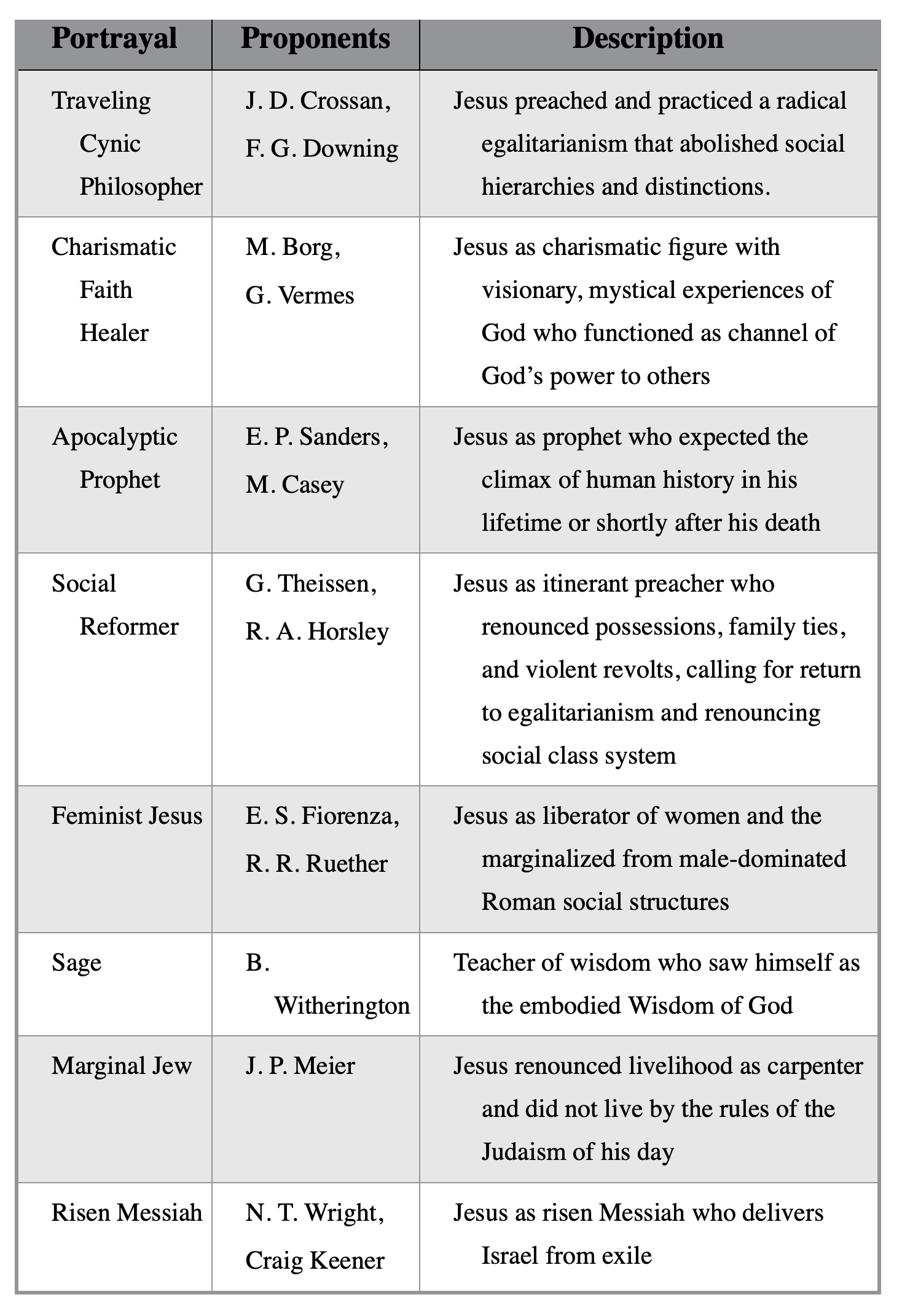
5. What are the dates for Jesus' birth and death, and what is a critical datum for dating Jesus's death?
If the traditional dates approximate the actual date of Jesus's birth, he was probably born in the winter of either 7–6 BC, 6–5 BC, or 5–4 BC, with a 6 or 5 BC date for Jesus's birth being the most likely.
Jesus's ministry likely began only a few months after John the Baptist. Luke 3:1–2 dates the beginning of the ministry of John the Baptist "in the fifteenth year of the reign of Tiberius Caesar..." The fifteenth year of Tiberius's reign likely fell within dates ranging from August 19, AD 28 to December 31, AD 29. Jesus's ministry likely began only a few months after John's.
Since John's Gospel records Jesus visiting Jerusalem three times for the Passover, Jesus' ministry lasted at least 2.5 years but more likely 3.5 years.
Jesus was crucified on a Friday (Matt 27:62; Mark 15:42; Luke 23:54; John 19:14, 31, 42) on the day of preparation for the Sabbath. The Passover meal was eaten by the Jews on Nissan 14, and the Gospels make clear that Jesus ate the Last Supper on the evening before his crucifixion (Matt 26:20; Mark 14:17; Luke 22:14; John 13:2). Therefore, the year of Jesus' execution must be a year in which Nissan 14 fell on a Thursday. This possibly occurred in AD 30 and definitely occurred in the year AD 33.
Since AD 30 would not allow for sufficient time between Jesus' baptism and death for his extensive public ministry, the most likely year of Jesus's death is AD 33.
6. What is the critical datum for dating Jesus's birth?
Matthew 2:1 and Luke 1:5 indicate that Jesus was born in the later years of the reign of Herod the Great. Josephus stated that an eclipse occurred shortly before Herod's death. (Josephus, Ant. 17.6.5–6 and 17.8.1§§167–181, 188–192) This eclipse has been dated to precisely March 12/13 in 4 BC. Herod died before Passover that same year between March 12 and April 11 in the year 4 BC. The date of Herod's death established the latest possible date for Jesus's birth.
7. What is a simple definition of the "Criterion of Multiple Attestations"?
The "Criterion of Multiple Attestations" suggests that material about Jesus is probably authentic if it appears in two or more ancient sources which did not rely on each other. Stanley Porter argues that "the criterion is able to establish general themes of the teaching of Jesus but does not usually enable scholars to reconstruct Jesus's actual words." (Köstenberger 166)
8 . What is the simple definition of the "Criterion of Dissimilarity"?
The "Criterion of Dissimilarity" suggests that material in the Gospels is authentic if the sayings or deeds of Jesus recorded in the account are dissimilar to those expected from the Judaism of his day and from the practices and theology of the early church. (Köstenberger 167)
9. Where do critical scholars assign the burden of proof regarding the authenticity of Jesus material in the Gospels?
Critical scholars often do NOT apply their criteria for authenticity consistently. They also abuse the criteria by automatically assuming that material not established as authentic by apply the criteria is necessarily inauthentic. Finally, critical scholars place an unreasonable burden of proof on the Gospel material. Historians generally accept the historical reliability of ancient sources unless there are good reasons for not doing so. In other words, the sources are deemed innocent until proven guilty. But for the New Testament Gospels, they are guilty until proven innocent. (Köstenberger 169–170)
10. What are the two major possibilities regarding the relationship among the Gospels?
Most scholars support the (1) Two-Gospel Hypothesis or (2) Markan Priority. The Augustinian view (the canonical order is also the chronological order in which they were written) has been defended by B.C. Butler (The Originality of St. Matthew, 1951) and J. Wenham (Redating Matthew, Mark, and Luke: A Fresh Assault on the Synoptic Problem, 1991)
11. In what order were the Gospels written according to the Augustinian hypothesis?
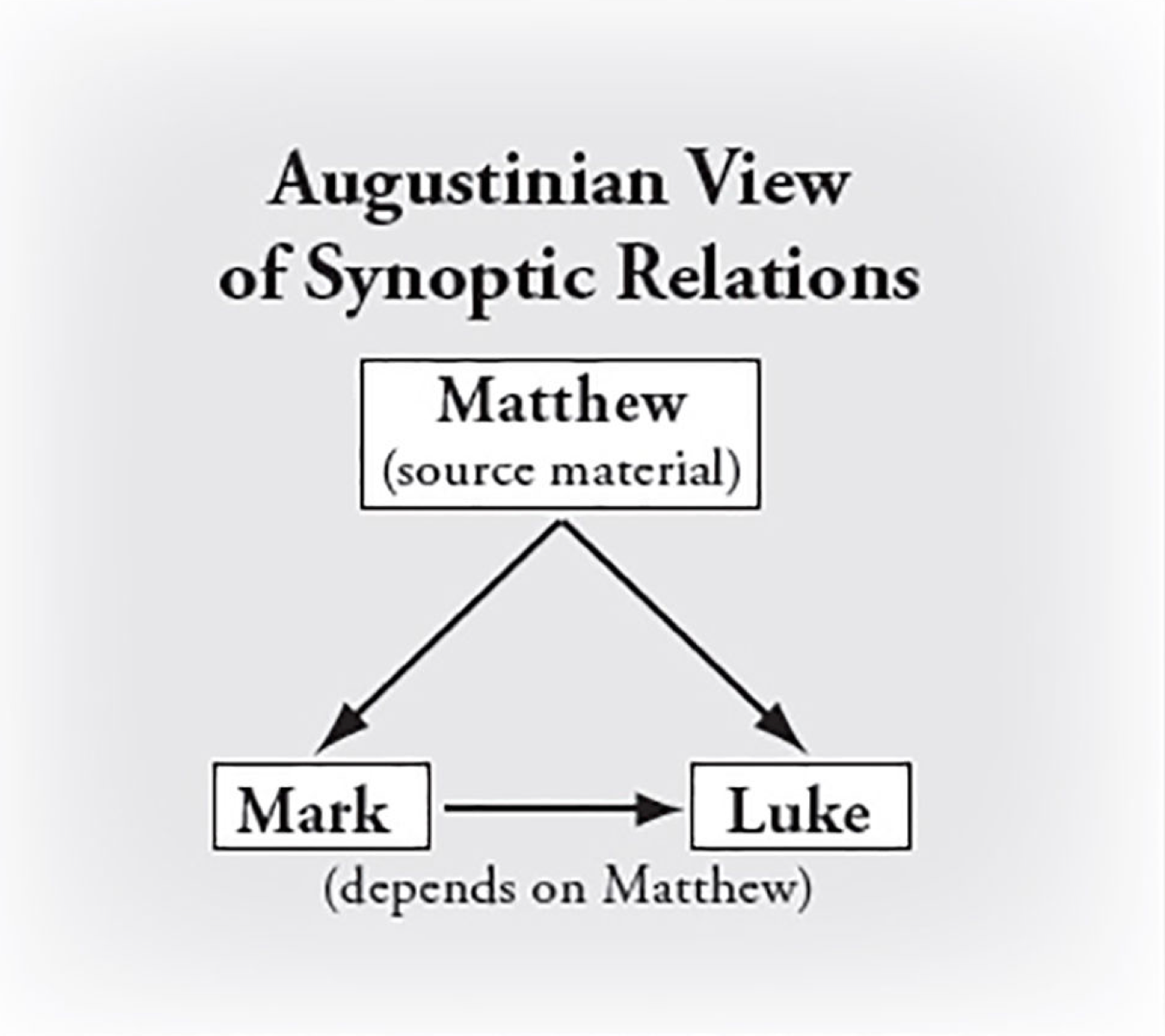
12. In what order were the Gospels written according to the two-Gospel hypothesis?
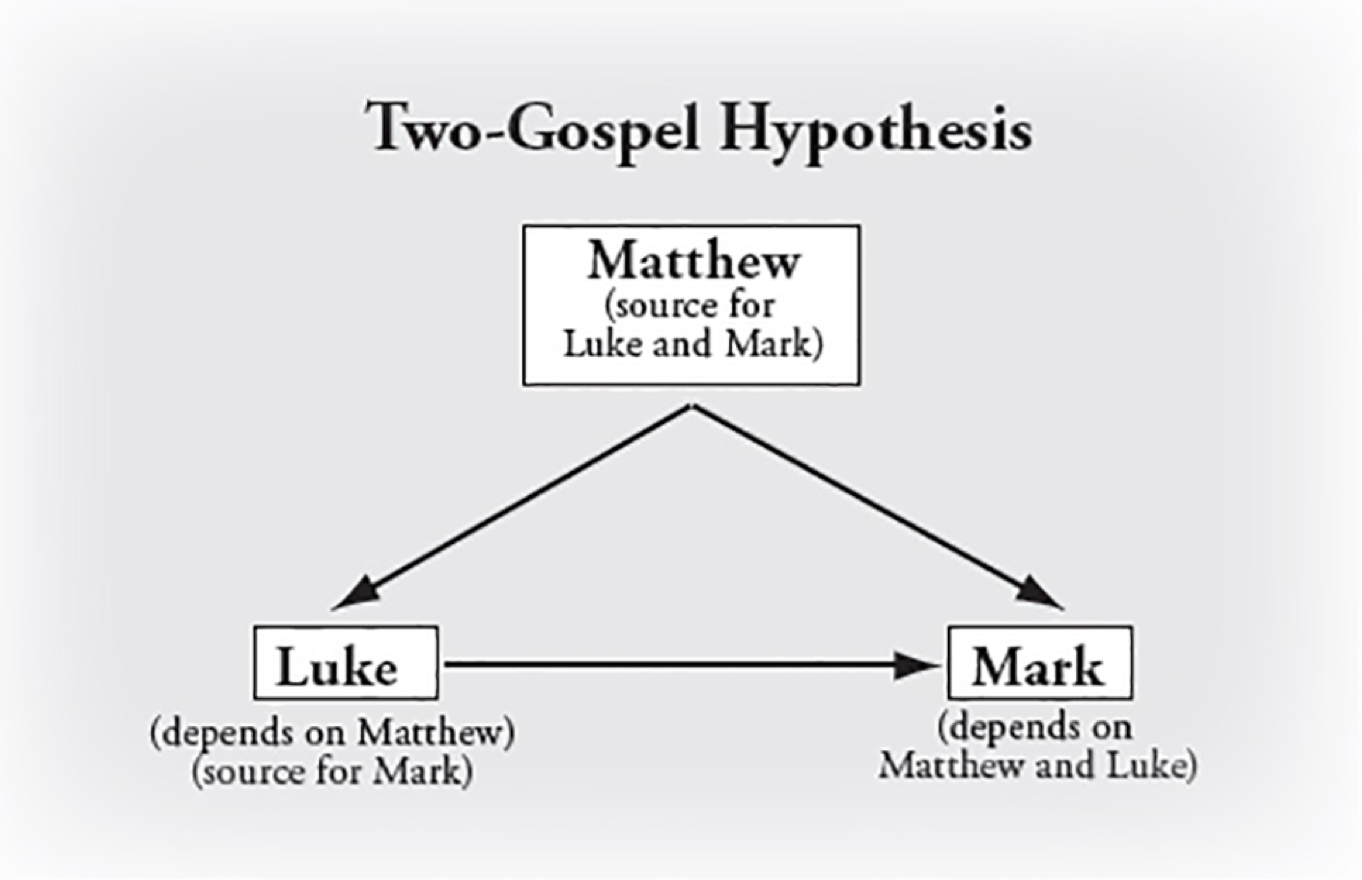
13. In what order were the Gospels written, according to the Markan priority view?
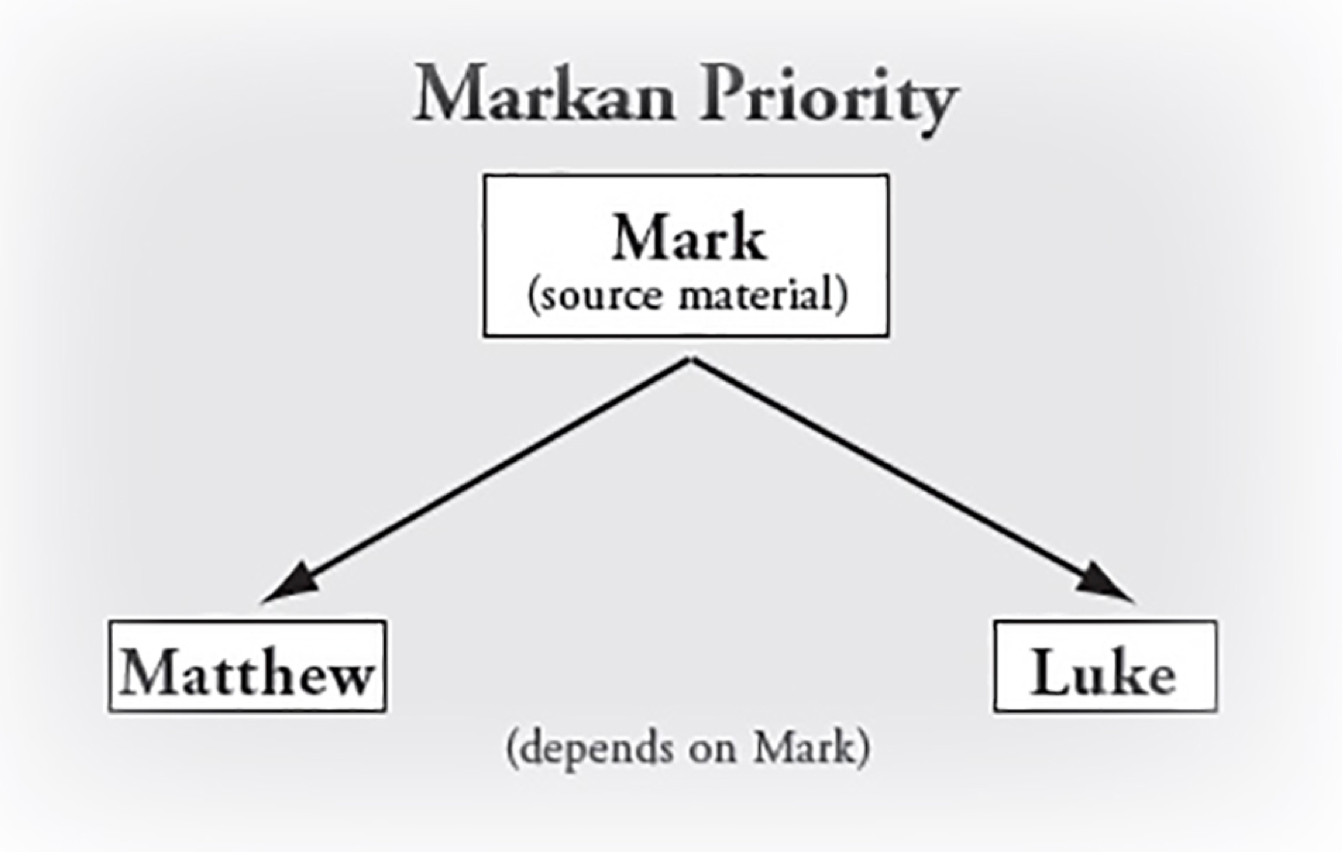 14. What is the two-document hypothesis?
14. What is the two-document hypothesis?
The two-document hypothesis argues that Mark was written first (Markan priority). When Matthew and Luke wrote their Gospels, they wrote independently of each other but relied heavily on Mark and an additional now-lost document known as "Q."
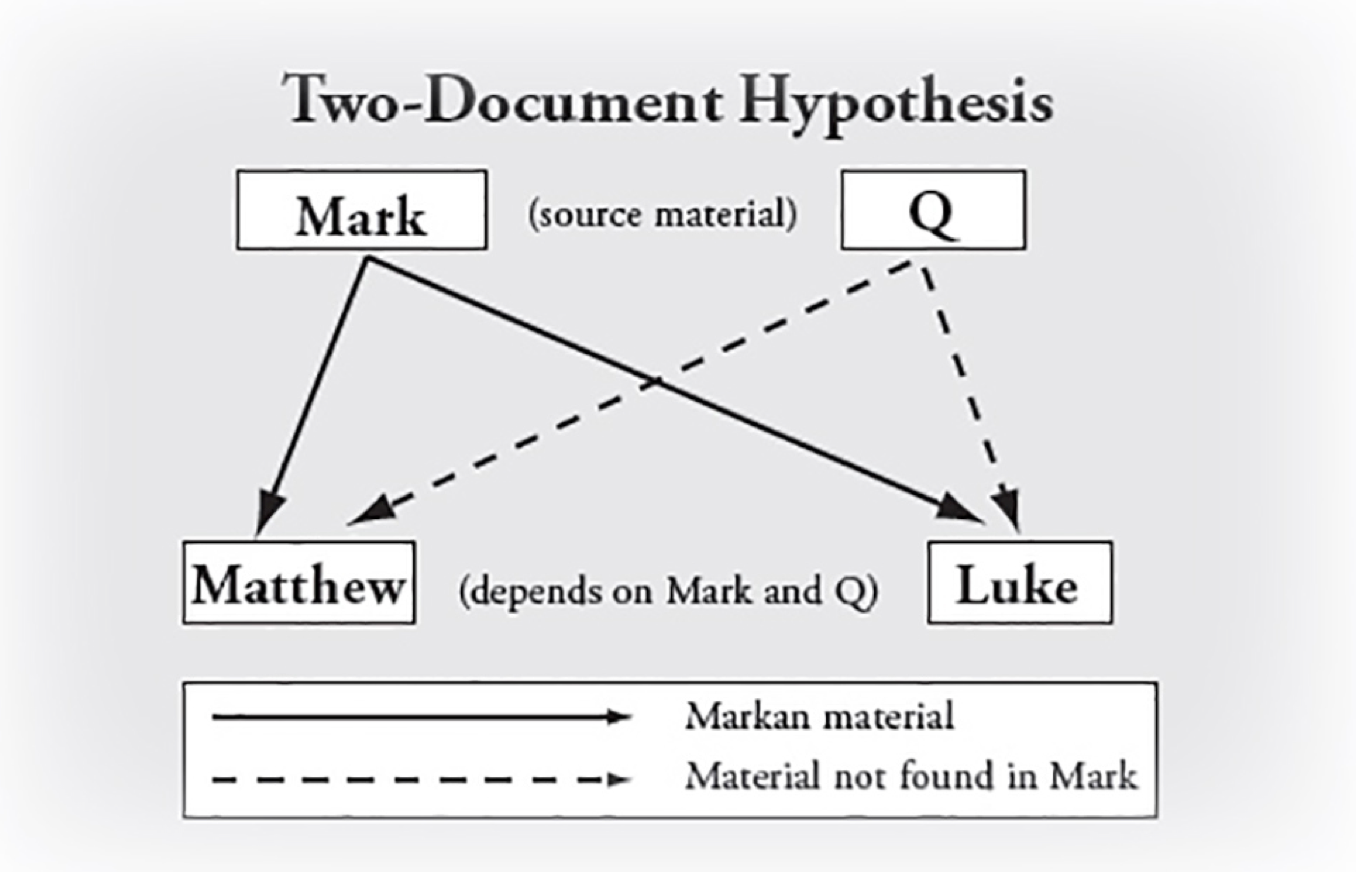
15. What is Q?
"Q" refers to a hypothetical source, and the letter "Q" probably came from the German word Quelle meaning "source." Some scholars argue that the material shared by Matthew and Luke but not by Mark can be explained by an appeal to another shared document (written source) because Matthew could not have used Luke, and Luke could not have used Matthew.
16. List the steps for interpretation of a Gospel pericope.
Vertical Reading
The interpreter should read the Gospel from start to finish without taking an extended break. Gospel writers assumed that this was the manner in which most readers would approach their accounts.
- Seek to understand how individual pericopes relate to the purposes of the Gospel as a whole.
- Examine themes in the headings, introductions, and programmatic statements.
- Examine repeated themes, titles, phrases, and theological emphases.
- Examine editorial comments that interpret the significance of the event.
- Note the response of the original witnesses to an event.
- Look for possible connections between narrative and discourse material in the immediate context.
- Carefully examine all OT quotations and allusions.
- Consider the significance of events against the background of OT teaching and first-century Jewish theology.
Horizontal Reading
Horizontal reading involves careful comparison of a pericope in a particular Gospel to parallel accounts in other Gospels.
- Locate parallel accounts in the Gospels, preferably by using a Gospel harmony or Gospel synopsis that arranges the text of the Gospels in parallel columns.
- Examine the similarities and differences between the parallel texts. Mark differences by highlighting or underlining.
- Consider whether the unique elements of a particular Gospel highlight theological emphases of that Gospel.
- Test the hypothesis regarding theological emphases by determining whether that same emphasis is reflected in other passages in that particular Gospel.
17. List the steps for the interpretation of a parable.
- Identify the main characters of the parable.
- Identify objects given special importance.
- Examine the structure of the parable.
- Identify details of the parable that seem shocking, extraordinary, unnatural, or unrealistic.
- Examine connections to introductions or conclusions to the parable.
- Examine connections to other parables in the same grouping.
- Apply steps for Gospel interpretation previously discussed.
Andreas J. Köstenberger, L. Scott Kellum, and Charles L. Quarles, The Cradle, the Cross, and the Crown: An Introduction to the New Testament, 2nd ed (Nashville, TN: B & H Publishing Group, 2016), 118–122. ↩︎
Köstenberger, Kellum, and Quarles, 123. ↩︎
Köstenberger, Kellum, and Quarles, 118–121. ↩︎
Köstenberger, Kellum, and Quarles, 139. ↩︎




